For those who missed the powerful documentary, Blackfish, it is being rebroadcast in the U.S. on CNN at 9PM on Sunday night. When first broadcast on Thursday, the documentary swept the ratings among every group under 55 years old. An interview with the director, Gabriela Cowperthwaite.
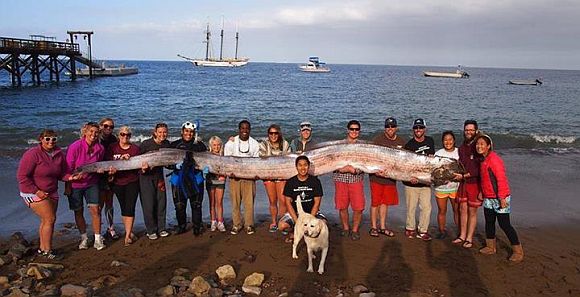 Last week, two rare oarfish washed up (or in the case of the first was dragged up) on the shores of Southern California. Yesterday, Japan was stuck by a 7.3 magnitude earthquake. A coincidence? It seems that there is Japanese folklore that says that sighting of oarfish portends a coming earthquake. Oarfish are the longest bony fish in the ocean and can grow up to around 17 meters or 56 feet long. The two that washed up in California were only 18′ and 14′ long, which is still very impressive. Oarfish, which tend to stay in deep water, are rarely seen on the surface. When they do make an appearance they are understandably often referred to as “sea serpents,” given their long snake-like bodies. It is easy to understand how they might be useful in folklore as a predictor of ill-tidings. If sea serpents start appearing, something bad must be coming. In Japan, the oarfish is traditionally known as the “Messenger from the Sea God’s Palace.” (If the Sea God is sending you a message, it is better sent by a sea serpent rather than a sea bass.)
Last week, two rare oarfish washed up (or in the case of the first was dragged up) on the shores of Southern California. Yesterday, Japan was stuck by a 7.3 magnitude earthquake. A coincidence? It seems that there is Japanese folklore that says that sighting of oarfish portends a coming earthquake. Oarfish are the longest bony fish in the ocean and can grow up to around 17 meters or 56 feet long. The two that washed up in California were only 18′ and 14′ long, which is still very impressive. Oarfish, which tend to stay in deep water, are rarely seen on the surface. When they do make an appearance they are understandably often referred to as “sea serpents,” given their long snake-like bodies. It is easy to understand how they might be useful in folklore as a predictor of ill-tidings. If sea serpents start appearing, something bad must be coming. In Japan, the oarfish is traditionally known as the “Messenger from the Sea God’s Palace.” (If the Sea God is sending you a message, it is better sent by a sea serpent rather than a sea bass.)
But does the appearance of oarfish really predict an earthquake? Continue reading

The Noisy Plainfin Midshipman
There are many hazards of the sea. One of the least dangerous, yet still highly annoying and somewhat mysterious is the loud humming sound heard coming from the sea on summer nights by residents of coastal towns, in boats or in houses near the shore. The hum has been described variously as similar to the drone of a B-29 bomber or a giant electric shaver.
It is unclear how long this subsea hum has been keeping coastal dwellers awake, but in 1985, after complaints from houseboat dwellers in Sausilito, California, volunteers from a local aquarium found the answer.

Photo: Christian @ShipSpotting.com
Pirates are reported to have seized the captain and chief engineer from the US Flag offshore supply vessel, C-Retriever, which was attacked in the Gulf of Guinea off the coast of Nigeria early Wednesday. Both the captain and chief engineer are US citizens. The supply boat is owned by Edison Chouest which is based Louisiana.
“We are closely monitoring reports that two U.S. citizens have been kidnapped from a U.S.-flagged vessel, the C-Retriever, in the Gulf of Guinea,” a State Department official told NBC News. “We are seeking additional information about the incident.” Thanks to Phil Leon for contributing to the post.
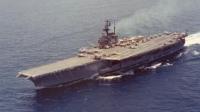 The first US Navy “supercarrier,” the USS Forrestal was recently sold for scrap for the sum of one penny to the All Star Metals scrap yard in Beaumont, Texas. The Navy offered the carrier as a museum but did not receive any suitable applications. The ship is the first of three carriers scheduled to hit the scrapyard over the next few years. Built in Newport News Shipyard and commissioned in 1955, in her day she was the largest aircraft carrier ever built. Sadly, the ship is best known for a major fire and explosions on her flight deck in 1967 in which 134 sailors died and 161 were injured. Other serious fires in 1978 and 1989 earned her the nicknames, “Firestal”, “Forrestfire” and “USS Zippo.”
The first US Navy “supercarrier,” the USS Forrestal was recently sold for scrap for the sum of one penny to the All Star Metals scrap yard in Beaumont, Texas. The Navy offered the carrier as a museum but did not receive any suitable applications. The ship is the first of three carriers scheduled to hit the scrapyard over the next few years. Built in Newport News Shipyard and commissioned in 1955, in her day she was the largest aircraft carrier ever built. Sadly, the ship is best known for a major fire and explosions on her flight deck in 1967 in which 134 sailors died and 161 were injured. Other serious fires in 1978 and 1989 earned her the nicknames, “Firestal”, “Forrestfire” and “USS Zippo.”
USS Forrestal Sold For 1 Cent, Heads To Scrapyard
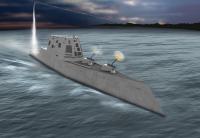 At about the same time that the Forrestal was sent to scrap, Bath Iron Works in Maine floated USS Zumwalt, the first of three new high tech destroyers. (The USS Zumwalt‘s scheduled christening was cancelled due to the recent US government shut-down and is being rescheduled for this spring.) If USS Forrestal was a “supercarrier” the USS Zumwalt may be a “superdestroyer,” and a super expensive one, at that.
At about the same time that the Forrestal was sent to scrap, Bath Iron Works in Maine floated USS Zumwalt, the first of three new high tech destroyers. (The USS Zumwalt‘s scheduled christening was cancelled due to the recent US government shut-down and is being rescheduled for this spring.) If USS Forrestal was a “supercarrier” the USS Zumwalt may be a “superdestroyer,” and a super expensive one, at that.
On Thursday October 24th, at 9PM E.T. in the United States, CNN will broadcast the documentary, Blackfish, directed by Gabriela Cowperthwaite. Blackfish looks at the almost 40 year history of orcas in captivity, leading up to the killing of SeaWorld trainer Dawn Brancheau in 2010 by the 12,000-pound orca, Tilikum, a whale previously associated with the death of two other people. (See our previous post.)
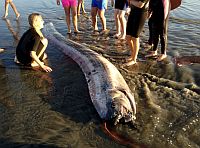 A second rare oarfish has washed up on the California coast. Last week a dead 18 foot oarfish was found by a snorkeling marine science instructor off Catalina Island. On Sunday, a second 14′ long oarfish washed up on a beach near Oceanside, also in Southern California. Milton Love, a research biologist at the Marine Science Institute at UC Santa Barbara speculates that both fish might have been carried shore-ward by the same current.
A second rare oarfish has washed up on the California coast. Last week a dead 18 foot oarfish was found by a snorkeling marine science instructor off Catalina Island. On Sunday, a second 14′ long oarfish washed up on a beach near Oceanside, also in Southern California. Milton Love, a research biologist at the Marine Science Institute at UC Santa Barbara speculates that both fish might have been carried shore-ward by the same current.
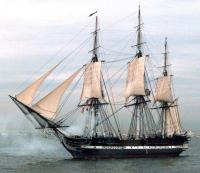 October 21st is a busy day in nautical history. In addition to being the anniversary of the Battle of Trafagar of 1805, it was also the day that the the USS Constitution was launched in 1797. A three-masted US Navy heavy frigate, she is the world’s oldest commissioned naval vessel afloat. USS Constitution was the third of six original frigates authorized for construction by the Naval Act of 1794.
October 21st is a busy day in nautical history. In addition to being the anniversary of the Battle of Trafagar of 1805, it was also the day that the the USS Constitution was launched in 1797. A three-masted US Navy heavy frigate, she is the world’s oldest commissioned naval vessel afloat. USS Constitution was the third of six original frigates authorized for construction by the Naval Act of 1794.
Happy Trafalgar Day – the celebration of the victory won by the Royal Navy, commanded by Vice-Admiral Horatio Nelson, over the combined French and Spanish fleets at the Battle of Trafalgar on October 21, 1805. Nelson died in his greatest victory. Here is a 3D animation of the battle by Chaîne de Rostokouban.
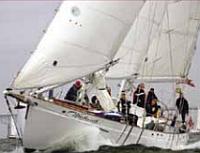 Congratulations to all the racers in this year’s Great Chesapeake Bay Schooner Race. In last year’s race, Woodwind, Heron and Prom Queen, the top three Class A schooners (from 40′ to less than 50′) all beat the elapsed and corrected time of the Class AA schooners (50′ and above.) This year’s race saw the top two Class A schooners, America 2.0 and last years first place winner, Woodwind, beat the Class AA schooners on both elapsed and corrected time. Prom Queen, finishing third in Class A, beat the Class AA schooners on corrected time. The top three Class AA schooners this year were Pride of Baltimore II, Virginia and Lady Maryland.
Congratulations to all the racers in this year’s Great Chesapeake Bay Schooner Race. In last year’s race, Woodwind, Heron and Prom Queen, the top three Class A schooners (from 40′ to less than 50′) all beat the elapsed and corrected time of the Class AA schooners (50′ and above.) This year’s race saw the top two Class A schooners, America 2.0 and last years first place winner, Woodwind, beat the Class AA schooners on both elapsed and corrected time. Prom Queen, finishing third in Class A, beat the Class AA schooners on corrected time. The top three Class AA schooners this year were Pride of Baltimore II, Virginia and Lady Maryland.
 “All is Lost” a new film by J. C. Chandor, starring Robert Redford is about a solo sailor whose 39-foot sail boat is struck by a floating shipping container while 1,700 miles off the Sunda Strait and which later sinks in a storm. Redford is the only cast member and there is virtually no dialog. The movie has received rave reviews, particularly for Redford’s low key but gripping performance. I saw it yesterday afternoon and it is indeed much of what the reviewers praise – a well paced, intense and engaging adventure story with an amazing, if almost entirely mute, performance by Robert Redford, the unnamed sailor, who the the credits only identify as “Our Man.” Nevertheless, I left the movie theater disappointed.
“All is Lost” a new film by J. C. Chandor, starring Robert Redford is about a solo sailor whose 39-foot sail boat is struck by a floating shipping container while 1,700 miles off the Sunda Strait and which later sinks in a storm. Redford is the only cast member and there is virtually no dialog. The movie has received rave reviews, particularly for Redford’s low key but gripping performance. I saw it yesterday afternoon and it is indeed much of what the reviewers praise – a well paced, intense and engaging adventure story with an amazing, if almost entirely mute, performance by Robert Redford, the unnamed sailor, who the the credits only identify as “Our Man.” Nevertheless, I left the movie theater disappointed.
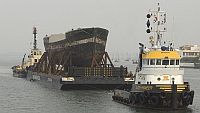 The composite clipper ship, City of Adelaide, which had been renamed HMS Carrick, was officially renamed the City of Adelaide once at a ceremony on the River Thames at Greenwich near London. Prince Philip, the Duke of Edinburgh, was accidentally sprayed with champagne during the ceremony, but was good-natured about it all, remarking “how very Australian.” The renaming ceremony for the 1864 built clipper ship was held near where the only other surviving composite clipper, Cutty Sark is preserved in drydock. City of Adelaide is five years older than the Cutty Sark. Both are composite clippers, which means that they have wooden planks over iron or steel frames and keel.
The composite clipper ship, City of Adelaide, which had been renamed HMS Carrick, was officially renamed the City of Adelaide once at a ceremony on the River Thames at Greenwich near London. Prince Philip, the Duke of Edinburgh, was accidentally sprayed with champagne during the ceremony, but was good-natured about it all, remarking “how very Australian.” The renaming ceremony for the 1864 built clipper ship was held near where the only other surviving composite clipper, Cutty Sark is preserved in drydock. City of Adelaide is five years older than the Cutty Sark. Both are composite clippers, which means that they have wooden planks over iron or steel frames and keel.

Meux’s Horse Shoe brewery, Tottenham Court Road
Toward the end of September, we posted about Matson’s molasses spill in Hawaii and then the Great Boston Molasses Flood of 1919. We would be remiss if we did not also post about the London Beer Flood which occurred on this day, 199 years ago. It was not strictly a nautical event but as beer is always of interest to sailors, we consider it to be close enough. (For the sake of propriety we will not post about the Pig Manure Flood in the German village of Elsa in 2006.)
It is not easy to separate fact from fiction in the accounts of the London Beer Flood of 1814. The bare-bones facts seem to be that a vat of porter containing 3,555 barrels of beer, burst suddenly at around 5:30 PM on Monday October 17, 1814, in Henry Meux’s Horse Shoe Brewery in the parish of St. Giles, London, England. Eight people, all women and children in tenements adjacent to the brewery, are believed to have died in the flood of more than 570 tonnes of beer.
The Parade of Sail in the 2013 Great Chesapeake Bay Schooner Race starts in a few minutes from Canton, MD in Baltimore harbor. The race begins tomorrow at 1330 just south of the Chesapeake Bay Bridge near Annapolis and ends 127 nautical miles down the Chesapeake Bay in Portsmouth, Virginia. To track the schooners live during the race, click on the GCBSR banner at the bottom of Baltimore Marine Centers’ home page to register & get the link. A video of last year’s Parade of Sail.

Photo:Catalina Island Marine Institute
Oar fish are real “sea serpents.” They can grow to be 50′ long and are the longest bony fish in the world. As they live in deep water, they are rarely seen on the surface. Nevertheless, over the weekend, Jasmine Santana, a marine science instructor at the Catalina Island Marine Institute, found an 18’dead oar fish while snorkeling off the California coast. With the help of 15 or 20 of the crew of sailing school vessel Tole Mour and institute instructors she carried the rare fish to shore.
18-foot-long oarfish found off California coast
“We’ve never seen a fish this big,” said Mark Waddington, senior captain of the Tole Mour, CIMI’s sail training ship. “The last oarfish we saw was three feet long.”
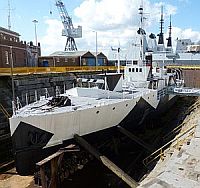 Monitor HMS M33, only surviving warship from the Gallipoli campaign of World War I, has received £1.79m from the UK’s Heritage Lottery Fund to allow the ship to be restored in time for the 100th anniversary of the campaign.
Monitor HMS M33, only surviving warship from the Gallipoli campaign of World War I, has received £1.79m from the UK’s Heritage Lottery Fund to allow the ship to be restored in time for the 100th anniversary of the campaign.
GALLIPOLI VETERAN WARSHIP HMS M33 TO BE RESTORED IN TIME FOR CENTENARY
Monitor HMS M33 once shelled Turkish positions in the Dardanelles during the ill-fated campaign to advance up the peninsula, seize Constantinople and knock the Ottoman Empire out of World War 1.
This sounds like the title of a made-for-TV movie from the SyFy channel. JEROS, Jellyfish Elimination Robotic Swarm, are jellyfish-shredding semi-autonomous robots designed by Korea Advanced Institute of Science and Technology (KAIST) to round up jellyfish in nets and shred thousands per hour. We recently posted about a Swedish nuclear power plant that had been shut down by a swarm of moon jellyfish. JEROS could be the first line of defense against a jellyfish horde. Then again, depending on the jellies, it could make matters worse.
These Robots Hunt Jellyfish–And Then Liquify Them With Rotating Blades Of Death
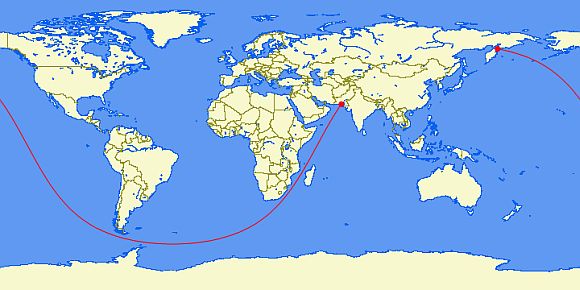 How far can you sail in a straight line without hitting land? The answer appears to be an almost 20,000 mile voyage from Pakistan to the Kamchatka Peninsula in Russia. The red line on the map, above, shows the voyage.
How far can you sail in a straight line without hitting land? The answer appears to be an almost 20,000 mile voyage from Pakistan to the Kamchatka Peninsula in Russia. The red line on the map, above, shows the voyage.
OK, so the red line looks anything but straight. Nevertheless, it is a straight line as projected on a flat map. The earth is anything but flat. Check out the video below to see the line projected on a spherical earth. What we are seeing is a great circle route between Pakistan to the Kamchatka Peninsula in Russia, which happens to stay clear of land. A great circle is an arc representing the shortest distance between two points anywhere on the Earth’s surface. Thanks to Patrick Anderson for uploading the video.
A straight line without hitting land from Pakistan to Russia
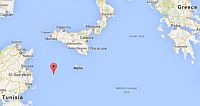 For the second time in roughly a week, a smuggler’s boat overloaded with migrants from Africa has capsized in the Mediterranean off Sicily, near the island of Lampedusa. At least 27 died, but 221 were rescued from the water. The boat capsized 65 miles (105 kilometers) southeast of Lampedusa.
For the second time in roughly a week, a smuggler’s boat overloaded with migrants from Africa has capsized in the Mediterranean off Sicily, near the island of Lampedusa. At least 27 died, but 221 were rescued from the water. The boat capsized 65 miles (105 kilometers) southeast of Lampedusa.
As we posted last Friday, another migrant boat sank last week in which 155 survived. The death toll from the previous sinking has risen to 232 with more than a hundred still missing. An estimated 6,500 have died off Sicily attempting to flee from Africa between 2004 and 2013. Thanks to Alaric Bond for contributing to the post.
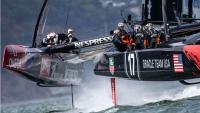 For anyone in the New York Area I will be speaking at the New York Shiplore and Model-makers Club on Tuesday night at 7:30 PM on the “AC72 and the Evolution of the America’s Cup.” The AC72 catamarans which raced in the recent competition have been described as more flying machines than sailboats. I will be examining how we got from the schooner yacht America of 1851 to the screaming AC72s of today, looking at the teams, the scandals, the upsets, and the technology that made this last America’s Cup so riveting. It should be a fun evening. If you are nearby on Tuesday, be sure to stop by 79 Walker Street, 5th floor — at 7:30 pm.
For anyone in the New York Area I will be speaking at the New York Shiplore and Model-makers Club on Tuesday night at 7:30 PM on the “AC72 and the Evolution of the America’s Cup.” The AC72 catamarans which raced in the recent competition have been described as more flying machines than sailboats. I will be examining how we got from the schooner yacht America of 1851 to the screaming AC72s of today, looking at the teams, the scandals, the upsets, and the technology that made this last America’s Cup so riveting. It should be a fun evening. If you are nearby on Tuesday, be sure to stop by 79 Walker Street, 5th floor — at 7:30 pm.
